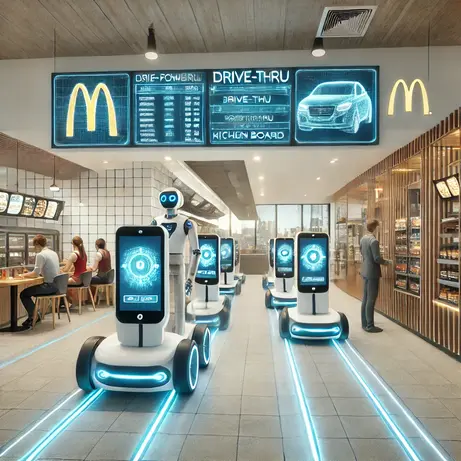
AI CERTS
2 months ago
McDonald’s Gives Its Restaurants an AI Makeover: A New Era of Fast Food Innovation
McDonald’s, the global fast-food giant, is stepping into the future with a groundbreaking AI-driven transformation of its restaurants. This ambitious move aims to enhance customer experiences, streamline operations, and optimize efficiency through advanced artificial intelligence (AI) technologies. By integrating AI-powered ordering systems, smart kitchen automation, and personalized customer interactions, McDonald’s is redefining the fast-food industry with cutting-edge digital advancements.
The fast-food chain has been experimenting with AI for several years, but recent developments signal a full-scale implementation of these innovations across its outlets worldwide. From AI-driven voice assistants at drive-thrus to predictive analytics that anticipate customer preferences, McDonald’s is leveraging AI to offer faster service, improved accuracy, and a more engaging dining experience. This AI makeover is set to transform how customers interact with McDonald's, making ordering more convenient while enabling the company to optimize inventory management and operational efficiency.

AI-Powered Ordering and Drive-Thru Automation
One of the most significant aspects of McDonald’s AI transformation is the implementation of AI-powered voice recognition at drive-thru lanes. The company has been testing automated ordering systems that use natural language processing (NLP) to understand and process customer requests. These AI-driven systems reduce human errors, speed up order processing, and allow for better personalization based on previous customer interactions.
McDonald’s has partnered with AI firms like IBM to refine its voice-recognition technology, ensuring that it can accurately take orders in different accents and dialects. This technology is already being tested in several locations, with promising results showing improved efficiency and customer satisfaction.
Additionally, digital menu boards at drive-thrus now use AI to recommend menu items based on factors like time of day, weather conditions, and historical customer preferences. For example, on a hot summer day, the menu may highlight cold beverages, while in the evening, it might promote burgers and fries.
Smart Kitchens and AI-Driven Food Preparation
McDonald’s is also integrating AI into its kitchens to improve food preparation and reduce waste. AI-powered kitchen management systems analyze real-time sales data to predict which menu items will be in high demand, ensuring that fresh food is prepared efficiently. This minimizes wait times and optimizes ingredient usage, reducing food waste and costs.
Automated kitchen equipment, such as robotic fryers and AI-monitored grills, ensures consistent cooking times and quality. By using machine learning algorithms, McDonald’s can maintain its signature taste and quality while increasing operational efficiency. These smart kitchen technologies allow employees to focus on customer service rather than repetitive cooking tasks, enhancing overall restaurant productivity.
AI-Enhanced Customer Experience and Personalization
AI is also revolutionizing how McDonald’s interacts with customers beyond ordering and food preparation. The company’s mobile app and self-service kiosks now utilize AI-driven personalization to offer tailored recommendations based on past purchases and preferences. Customers who frequently order certain menu items may receive exclusive discounts or loyalty rewards through AI-powered marketing campaigns.
Moreover, AI-driven customer support chatbots assist users with queries, order modifications, and dietary information, making digital interactions smoother and more responsive. By analyzing customer behavior, McDonald’s AI systems can refine marketing strategies, ensuring that promotions and advertisements resonate with the right audience.
The Future of AI in Fast Food
McDonald’s AI transformation is not just about improving current operations—it also sets the stage for the future of fast food. With ongoing advancements in AI, we can expect further innovations such as drone or robotic food delivery, biometric payment systems, and even AI-driven nutritional guidance.
The success of McDonald’s AI-powered model may inspire other fast-food chains to follow suit, leading to a broader industry shift toward automation and data-driven decision-making. While AI enhances efficiency and personalization, it also raises questions about job displacement in the fast-food sector. However, McDonald’s reassures that AI will assist employees rather than replace them, allowing staff to focus on customer service and higher-value tasks.
McDonald’s AI makeover marks a significant milestone in the evolution of the fast-food industry. By harnessing the power of artificial intelligence, the company is setting new standards for efficiency, accuracy, and customer engagement. From smart drive-thrus and automated kitchens to AI-driven personalization, McDonald’s is embracing digital transformation to stay ahead in the competitive fast-food landscape.
As AI continues to evolve, McDonald’s innovation-driven approach will likely inspire more advancements in the food service industry, making dining experiences faster, smarter, and more personalized than ever before. With this AI-powered shift, McDonald’s is not just serving food—it’s serving the future.
Sources-
https://www.wsj.com/articles/mcdonalds-gives-its-restaurants-an-ai-makeover-2134f01e
https://www.newsweek.com/first-ever-mcdonalds-served-robots-texas-1769116